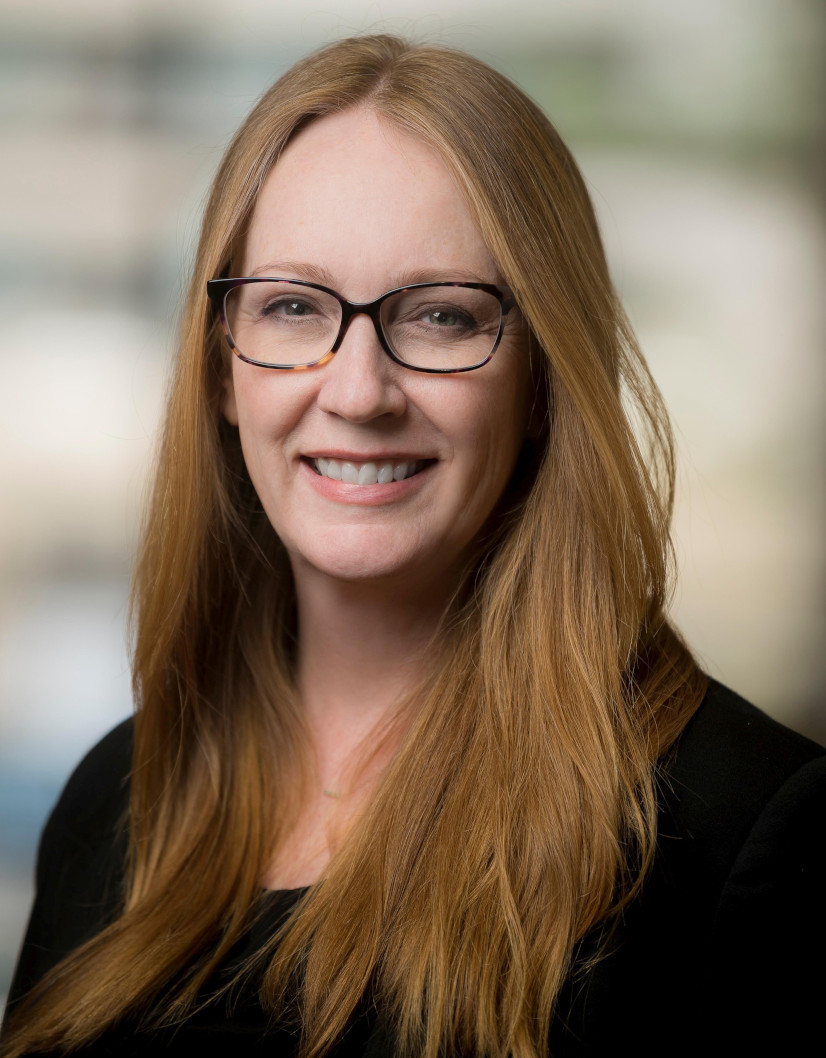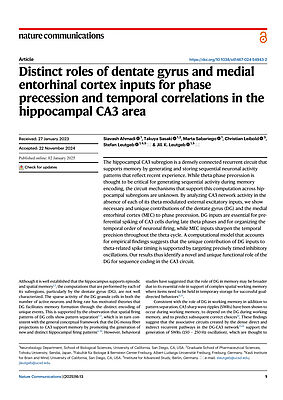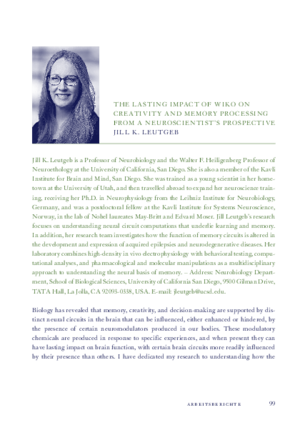
Jill K. Leutgeb, Ph.D.
Professor of Neurobiology, Walter F. Heiligenberg Professor of Neuroethology
University of California San Diego
Born in 1974 in Utah, USA
Studied Biology, Chemistry, Neurosciences, and Oncological Sciences at the University of Utah and Neurophysiology at the Otto von Guericke University Magdeburg
Arbeitsvorhaben
How Memory Circuits in the Brain Use Information about the Past to Inform Future Choices
Learning and memory are core cognitive functions that are supported by complex neural circuits in the brain. The key region for the formation of new autobiographical memories is the hippocampus. Within the hippocampus, the dentate gyrus (DG) is a highly specialized brain region with unique properties. First, the DG has particularly expanded in the mammalian lineage and is the subregion with the highest number of neurons. Second, neurons in the DG continue to be born in the adult brain, which is unique among brain regions and is thought to convey a heightened level of plasticity. Third, neurons in the DG have large specialized synapses, such that activity in target neurons can be elicited by one or just a few inputs. While the many specializations point to the hippocampal DG network as a key region for memory-related computations, the function of the DG remains understudied and poorly understood compared with other modules in memory networks. Understanding DG network computations is essential for therapeutic intervention in disease, as cellular changes in the DG are among the first to be identified in aging, depression, and epilepsy. My previous work has shown that neuronal activity patterns in the DG have a pivotal role in pattern separation. Pattern separation is an essential neural computation that allows for similar memories to be stored in distinct subpopulations of neurons, such that memories do not interfere with each other. More recently, I have discovered that neuronal activity in the DG not only distinguishes among similar patterns, but may also contribute to the planning of future actions. However, it remains unknown how the computations in the DG are integrated into a broader network that processes the outcome of past actions to inform future memory-guided choices. My goal is to experimentally and conceptually advance our understanding of the neural mechanisms for memory and decision making by focusing on computations that originate in dentate networks.Recommended Reading
Leutgeb, Jill K., Stefan Leutgeb, May-Britt Moser, and Edvard I. Moser (2007). “Pattern Separation in the Dentate Gyrus and CA3 of the Hippocampus.” Science 315: 961–966. https://doi.org/10.1126/science.1135801.
Mankin, Emily A., Fraser T. Sparks, Begum Slayyeh, Robert J. Sutherland, Stefan Leutgeb, and Jill K. Leutgeb (2012). “Neuronal Code for Extended Time in the Hippocampus.” Proceedings of the National Academy of Sciences 109: 19462–19467. https://doi.org/10.1073/pnas.1214107109.
Sasaki, Takuya, Verónica C. Piatti, Ernie Hwaun, Siavash Ahmadi, John E. Lisman, Stefan Leutgeb, and Jill K. Leutgeb (2018). “Dentate Network Activity Is Necessary for Spatial Working Memory by Supporting CA3 Sharp-Wave Ripple Generation and Prospective Firing of CA3 Neurons.” Nature Neuroscience 21: 258–269. https://doi.org/10.1038/s41593-017-0061-5.
Kolloquium, 06.02.2024
Die Biologie des Gedächtnisses und die besondere Rolle des Gyrus dentatus
Erinnerungen können sehr kurz – nur ein paar Sekunden – oder sehr lange – ein ganzes Leben lang – gespeichert werden. Was ist die biologische Grundlage dafür oder worin besteht die Veränderung im Gehirn, die die Elemente einer Erfahrung so sammelt, dass sie zu einem späteren Zeitpunkt als Erinnerung in unserem Bewusstsein wiederhergestellt werden kann? Was verleiht dem Gehirn die Fähigkeit, nicht nur genaue Erinnerungen an vergangene Ereignisse zu erzeugen, sondern Informationen auch so zu speichern, dass sie flexibel und kreativ genutzt werden können? Die Antworten auf diese Fragen hängen von der Entschlüsselung der Funktion einer hochspezialisierten Hirnregion ab, des Gyrus dentatus. Bevor wir den Gyrus dentatus näher betrachten, sehen wir uns die Bausteine des Gehirns und die Instrumente an, mit denen Forscher die Rechenoperationen neuronaler Netzwerke messen, während das Gehirn bestimmte Erinnerungen erzeugt, speichert und abruft. Mit dem Verständnis der Grundkomponenten erkennen wir auch die Beschränkungen der Hirnbereiche, die sensorisches Input verarbeiten und damit zur Bildung bewusster Erinnerungen beitragen; dort werden verschiedene Sinnesdaten zusammengeführt, z. B. was wir riechen, sehen, hören, berühren und fühlen. Es wird deutlich, dass das Gehirn spezieller neuronaler Schaltkreise zur Erinnerungsbildung bedarf und dass die Schaltkreise für die Bildung und den Abruf von Erinnerungen eine spezialisierte Hirnstruktur nutzen – den Gyrus dentatus. Die Neuronen und die Plastizität der Verbindungen zwischen den Neuronen des Gyrus dentatus sind hochspezialisiert, um mehrere Berechnungsprobleme zu lösen. So wird etwa die Aufgabe, Informationen über ein Ereignis als eine Erinnerung zu speichern, die sich von anderen unterscheidet, auf ähnliche Weise gelöst, wie unsere Regierungen einzelne Autos kennzeichnen. Wie ein bestimmtes Autokennzeichen wird jede Erinnerung als spezifisches Muster der Netzwerkaktivität kodiert – ein Prozess, der nur durch die ungewöhnlich hohe Anzahl stark gehemmter Zellen im Gyrus dentatus möglich ist. Doch wie bei Autokennzeichen sind die eindeutigen Kombinationen schnell ausgeschöpft, wenn es kein System zur Erweiterung möglicher Kombinationen gibt. Die Gedächtniskapazität hat also eine Grenze, die durch die Funktionsmerkmale des Gyrus dentatus festgelegt ist. Daher ist der Verlust von Erinnerungen oft die Folge einer beginnenden Degeneration des Gyrus dentatus, wie etwa im Alterungsprozess und bei einer Temporallappenepilepsie. Mit zunehmendem Wissen über die Funktion des Gyrus dentatus verstehen wir die Zellbiologie der Kodierung und des Abrufs von Erinnerungen nun besser. Dies zeigt sich darin, dass Wissenschaftlerinnen und Wissenschaftler in der Lage sind, Versuchstieren bestimmte Erinnerungen einzupflanzen, sie zu löschen und künstlich zu exprimieren. Darüber hinaus decken neue Beobachtungen die Mechanismen auf, wie gespeicherte Erinnerungen genutzt werden, um zukünftige Entscheidungen zu treffen. Neue, unerwartete Forschungsergebnisse zeigen, dass der Gyrus dentatus für die Vorstellung und Planung von Handlungen in der Zukunft erforderlich ist. Derzeit arbeite ich an Theorien und künstlichen neuronalen Netzen, damit künftige biologische Experimente durch die Identifizierung von Schlüsselmechanismen für diese kognitive Flexibilität auf bessere Informationen zurückgreifen können.
Publikationen aus der Fellowbibliothek
Leutgeb, Jill K. (London, 2025)
Leutgeb, Jill K. (New York, NY, 2021)
Precisely timed theta oscillations are selectively required during the encoding phase of memory
Leutgeb, Jill K. (New York, NY Nature America, 2018)
Leutgeb, Jill K. (Washington, DC, 2012)
Neuronal code for extended time in the hippocampus
Leutgeb, Jill K. (Washington, DC, 2007)
Pattern separation in the dentate gyrus and CA3 of the hippocampus

